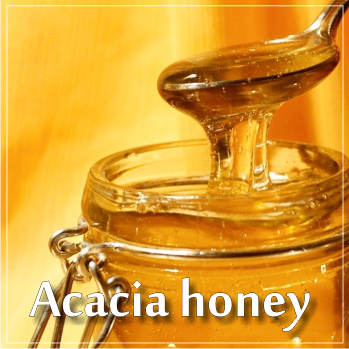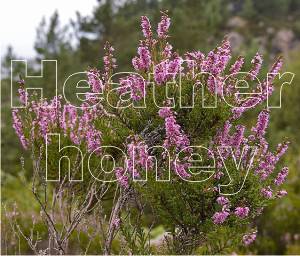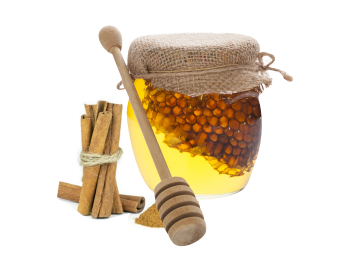It’s true: Acacia honey isn’t made from acacia!
There are some unifloral types of honey that are similar all over the world, like acacia honey or linden honey. Others are only appreciated in specific parts of world, like honeydew honey (fir or pine honey) is in Europe. Other types like eucalyptus, thyme, orange blossom honey are appreciated more in their origin places.
But all Americans love acacia honey. Probably because the tree originates from their country, or because of the purity of the color and distinct flavor. But I don’t think they know they are not exactly eating acacia honey, made from the flowers of acacia tree.
It’s from false acacia!
The acacia honey as we know it, is made of BLACK LOCUST tree, on its scientific name: Robinia Pseudocacia. False acacia!
The False Acacia, aka black locust (Robinia pseudoacacia), is a tree native to the southeastern United States, which has been widely planted and naturalized in temperate North America, Europe, Southern Africa and Asia. Now it is even considered an invasive species, in some areas. It blooms in May or June, after the leaves have appeared. The flowers are borne in loose drooping racemes, four to five inches long, cream-white, about an inch long, nectar bearing, fragrant.
Our acacia honey comes from the nectar of these beautiful flowers!
The Real Acacia, aka thorntree, whistling thorn, or wattle, is a genus of shrubs and trees with almost 1,300 species. 960 of them are native to Australia, and the rest spread around the tropical to warm-temperate regions of both hemispheres, including Europe, Africa, southern Asia, and the Americas. Read here about all these species.
The flowers are small, with five very small petals, almost hidden by the long stamens, which are arranged in dense, globular or cylindrical clusters. Their color is yellow or cream in most species, and some are whitish or even purple (Acacia purpureopetala) or red (Acacia leprosa (Scarlet Blaze)).
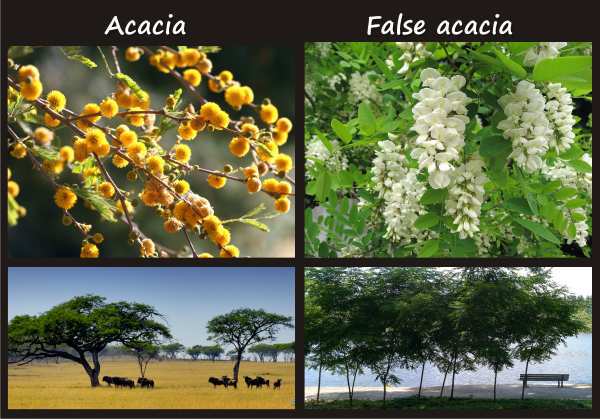
Do not confuse the black locust honey with the honey locust. Aka thorny locust, this is a tree native to central North America, where it is mostly found in the moist soil of river valleys ranging from southeastern South Dakota to New Orleans and central Texas, and as far east as eastern Massachusetts.
Despite its name, The honey locust is not a significant honey plant. The name derives from the sweet taste of the legume pulp, which was used for food by Native American people, and can also be fermented to make beer. But today it is mostly cultivated as ornamental tree.
The black locust tree 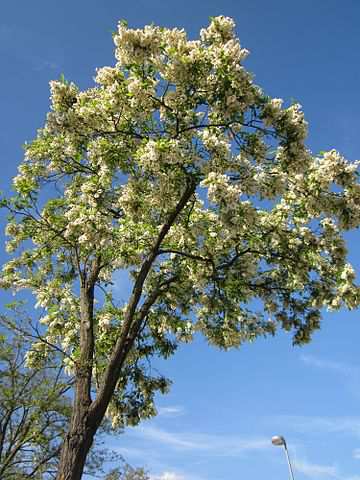
A tree of the genus Robinia in the subfamily Faboideae of the pea family Fabaceae.
In Europe we have often seen it alongside streets and in parks, especially in large cities, and enjoyed its incredible perfume. (They are not to be planted in small gardens because of their large size and rapid growth.)
It’s rot resistant!
It’s wood is well praised because it’s very hard, durable and resistant to rot, making it prized for furniture, flooring, paneling, fence posts and small watercraft.
Flavonoids in the heartwood allow the wood to last over 100 years in soil. In the Netherlands and some other parts of Europe, black locust is one of the most rot-resistant local trees, and projects have started to limit the use of tropical wood by promoting this tree and creating plantations.
It is one of the heaviest and hardest woods in North America.
Black locust is highly valued as firewood for wood-burning stoves. It burns slowly, with little visible flame or smoke, and has a higher heat content than any other species that grows widely in the Eastern United States (comparable to the heat content of anthracite).
It’s nitrogen fixing!
Black locust has nitrogen-fixing bacteria on its root system and for this reason it can grow on poor soils and is an early colonizer of disturbed areas.
The bark and leaves are toxic!
The bark and leaves are toxic, but the seeds are not. Shelled seeds are safe to harvest from summer through fall, and are edible both raw and/or boiled.
If a horse eats the plant, after 1 hour it will show signs of anorexia, depression, incontinence, colic, weakness, and cardiac arrhythmia. It should be immediately taken to a vet.
Yet, in traditional medicine of India, different parts of Robinia pseudoacacia are used as laxative, antispasmodic, and diuretic.
Why is it called “locust”?
It is said that Jesuit missionaries, fancied that this was the tree that supported St. John in the wilderness. Yet, the locust tree of Spain (Ceratonia siliqua or Carob Tree), which is also native to Syria and the entire Mediterranean basin, is supposed to be the true locust of the New Testament.
How is the black locust honey?
Sweeet….
Color: light water-white to extra-white
Granulation: slow, crystals form: coarse
Flavor: weak floral, fresh
Sweetness: very sweet. Because of its content of fructose which is higher than that of glucose, the acacia honey is sweeter. (compared to rape honey, which has a higher content of glucose). From here results that acacia honey has also a relatively lower GI.
Glycemic index and glycemic load for a serving (25 g) of honey:
Fructose (g /100 g): 43
GI: 32
Available carbohydrate (g/serving): 21
Glycemic load (per serving): 7
Acid content: lower. (This makes it delicious when combined with cheeses, especially pecorino and gorgonzola cheese. Because of its light taste, it is good for children and ideal on fresh cheeses (ricotta), yogurt, fruit and ice cream)
Conductivity: probably the lowest of all types of honey.
Vitamin content (A Sardinian type of acacia honey was measured) mg/kg:
Vit B2: <0.25
Vit B3: 5 ± 1
Vit B5: <1.75
Vit B9: <0.325
Vit C: 1.2 ± 0.2
Antioxidants (flavonoids): low content. According to the National Honey Board, darker honeys have higher levels of antioxidants. Acacia honey has around 46 milligrams per kilogram, versus buckwheat honey that contains about 796 milligrams per kilogram. But they are relative numbers, depending greatly on the origin place.

While it is known that honey added to non fat dry milk has a favorable influence on “good bacteria”, meaning that honey supports the growth of all strains, acacia honey did not affect the survival of the microbial flora of yoghurt during a 6 week refrigerated storage period. It had no effect on pH and lactic acid levels of the final products. (according to VARGA, L (2006) Effect of acacia (Robinia pseudo-acacia L.) honey on the characteristic microflora of yogurt during refrigerated storage. International Journal of Food Microbiology.)
Antibacterial potency: low-average,
Type of antibacterial activity: undetermined, non-peroxide
Antimutagenic activity: similar to glucose and fructose.
A study compared seven different floral honey (acacia, buckwheat, fireweed, soybean, tupelo and Christmas berry) against Trp-p-1 and compared to that of a sugar analogue and to individually tested simple sugars. All honeys exhibited significant STOP inhibition of Trp-p-1 mutagenicity. Glucose and fructose were found to be similar antimutagenic as honey and were more antimutagenic than maltose and sucrose. (WANG, X H et al., Antimutagenic effect of various honeys and sugars against Trp-p-1. Journal of agricultural and food chemistry, 2002).
Is it recommended to diabetics?
There are people recommending it for diabetics. Meaning, that if they have to chose one type of honey to eat instead of regular sugar, they should opt for acacia honey, because of the lower GI.
But this theory is not supported by all therapists. They suggest that the best honey for a diabetic should be the one with 1:1 ratio fructose – glucose.
The explanation is given by Ron Fessenden in his revolutionary book: The New Honey Revolution: Restoring the Health of Future Generations. (Amazon link). He says that a perfect ratio of fructose and glucose is completely transformed by the liver into glycogen, and there will be no other sugars left aside to enter the blood. This perfect ratio along flavonoids and all the others constituents of honey, some of them yet not identified, recommend it for the use of diabetics. Even leading to improvement of their condition.
• People are saying that
the Italian acacia honey is the best acacia honey ever tasted.
Have you tried it?
Other therapeutic effects of acacia (black locust) honey
Improves skin wound healing
In the study Effects of acacia honey on wound healing in various rat models, published by Pubmed in 2010, researched the effects of acacia honey on incision, excision, burn and dead-space wound models in rats. After treatment, the area of epithelization was found to increase, followed by an increase in wound contraction, skin-breaking strength, tissue granulation.
The hydroxyproline content also increased in the rats treated with higher doses of honey compared to control, indicating an increase in collagen formation.
Improves corneal abrasion healing
Biomedcentral.com published on February 2015, the study The effects of acacia honey on in vitro corneal abrasion wound healing model, by Choy Ker-Woon et al, from Universiti Kebangsaan Malaysia Medical Centre.
This study aimed to investigate the effects of acacia honey on cultured corneal epithelial cells (CEC) on in vitro corneal abrasion wound healing model. The results showed that “supplementation of acacia honey in basal medium and complete cornea medium media accelerates CEC wound closure of the in vitro corneal abrasion model, by increasing the expression of genes and proteins associated with CEC wound healing.”
The authors concluded that “acacia honey is a potential candidate for the establishment of Acacia honey based pharmaceutical eye drop for the treatment of corneal abrasion in the near future.”
Helps lung cancer healing
Pubmed published in 2013 the study “Molecular mechanism of antiproliferation potential of Acacia honey on NCI-H460 cell line.“, by Aliyu M et al., from the University of Ibadan, Nigeria.
The authors investigated the molecular mechanism of antiproliferation potential of Acacia honey on NCI-H460 cells by cell cycle, viability, cytokines, calcium ion and gene expression analysis.
The results showed that acacia honey inhibited cells proliferation, arrested G0/G1 phase, stimulated cytokines, calcium ion release as well as suppressed p53 and Bcl-2 expression in a dose-dependent manner.
Has preventive effects against different diseases, such as cancer
According to the study Molecular mechanism of antiproliferation potential of Acacia honey on NCI-H460 cell line., published by PubMed in 2010, Chrysin (5,7-dihydroxyflavone) a natural flavone commonly found in acacia honey is a powerful anti-tumor agent. The study investigated the antiproliferative role of honey or chrysin on human and murine melanoma cell lines. “Acacia honey induced an antiproliferative effect on melanoma cells in a dose- and time-dependent manner. Flow cytometry analysis indicated that cytotoxicity induced by honey or chrysin was mediated by G(0)/G(1) cell cycle arrest and induction of hyperploid progression.”
The results ahowed that Chrysin may be considered a potential candidate for both cancer prevention and treatment.
Ather therapeutical claims, yet not researched: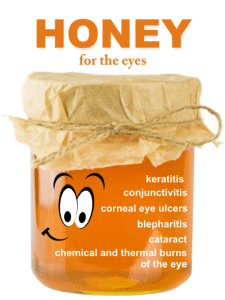
– relieves apnea,
– reduces complaints of asthma,
– increases bile acid.
– calms the nervous system, making it good to be taken before bedtime.
The fact that science hasn’t yet researched it, doesn’t make them false. Folk medicine is continually teaching us a lot, and we are constantly discovering how to use nature to improve our health.
It helps in treating eye conditions like conjunctivitis, keratitis, blepharitis, corneal eye ulcers, chemical and thermal burns of the eyes. Though it is not exactly simple accacia honey. Click on the picture to read the article about it.
![]() That as a young man, Abraham Lincoln spent much of his time
That as a young man, Abraham Lincoln spent much of his time
splitting rails and fence posts from black locust logs?
References and picture credits:
“20130528Robinie Hockenheim4” by AnRo0002 – Own work. Licensed under CC0 via Wikimedia Commons –
Black locust flowers picturew credit beautifulcataya under CC, via flickr.com
acacia flowers picture credit cobalt123 under CC, via flickr.com
trees of black locust picture credit Wendy Cutler under CC, via flickr.com
acacia trees picture credit Martin Heigan under CC, via flickr.com
ar with golden acacia honey picture credit Mariusz Szczepanik under CC, via flickr.com
http://en.wikipedia.org/wiki/Robinia_pseudoacacia
Honey as Nutrient and Functional Food: A Review by Stefan Bogdanov, Bee Product Science, February 2014

